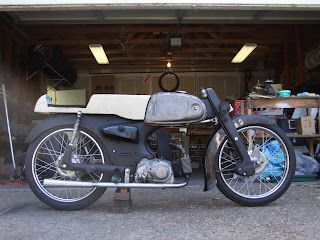Over the past few weeks, I've ordered an assortment of parts for Salty, ranging from NOS Piston kits, to larger front sprockets, to a couple sets of tires. This post will focus on the tires, and their fitment to the bike.
One of the "speed modifications" to this little bike is to gear it up. In stock form, the bike runs a 14-tooth front sprocket, and a 40-tooth rear sprocket, with a 2.25"x17" rear tire. Based on some calculations I've put together, this should put the top speed around 52-53mph at 10,000rpm. Perhaps I'm hugely over estimating the performance of the bike, but I wanted gearing options that would let me run at least 60mph.
One of the easiest solutions is to run a taller rear tire. That isn't a simple matter when it comes to small bike tires, however. I want to keep the tires fairly narrow too, so after much research I found the Michelin Gazelle M62 tire. This is a small motorcycle/moped tire that is speed rated to 82mph. It is available in several sizes, including a 2.25x17 (front) and a 3x17 (rear.)
However...nobody had any of these tires in stock. I talked to several vendors, and ended up having orders sitting around for more than 2 full months, with expected delivery dates getting pushed out further as each week passed by.
So, I researched more and came across the IRC NR53. It is a semi-slick treaded tire, again made for small motorcycles and mopeds. It too is speed rated, and offered in both a 2.25x17 and 2.75x17 size. I placed my order and within days I received one of four tires. I ordered two fronts and two rears. The other three tires are on back order, but hopefully might actually get shipped sometime this year!
I quickly mounted up the 2.75x17 rear tire to the rear wheel assembly I had put together. I'll call these the "chrome wheels" since I'm using a set of stock wheel rims with pretty decent chrome. I knew there could be some clearance issues under the rear fender with this wider rear tire, so I chucked it under the bike to see how bad it would be.
As it happens, I also took an opportunity to trim the rear fender. As the rules state, there can be no rear fender extending past the centerline of the rear wheel, but the seat can essentially act as the rear fender, which mine will. Sorta. The exact rules reads as:
...
5.F. FRONT AND REAR FENDERSFront and rear fenders may be removed. Generic, replacement typefenders may be substituted. Rear fenders may not extend beyondthe centerline of the front or rear axle. Elongated seat may act asrear fender and is subject to scrutineering....
So, I grabbed the cutting wheel and shortened the rear fender. Don't worry, lovers of originality, as I have several stock rear fenders sitting on the shelf from parts bikes ready to go on should I ever want to take it back to the original full-fendered look.
Rear tire mounted up, and rear fender shortened per rules:
As it sits, I barely rub when I'm fully loaded on the bike, at its lowest settings. It is barely rubbing on the edges of the tire. With just a little "spreading" of the rear fender - what's left of it - I should be able to go off-roading without rubbing.
In preparation for the other set of tires arriving, I put together a second full set of wheel assemblies this past weekend. We'll call these the "red wheels" since I painted them red to match up with the red tank and seat (more on that later.)
Second set of wheel assemblies, sittin' pretty waiting for fresh tires
Tommorow, I'll post about my newly found set of front sprockets.
C'











